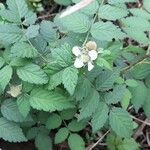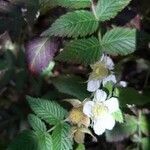A handsome scrambling shrub up to 2.5 m. tall, with erect or arching stems covered although scarcely densely so with long spreading white hairs interspersed with scattered or locally numerous amber-green glands.. Prickles scattered, small, up to 3 mm. long, straight or abruptly decurved.. Leaves imparipinnate (or the uppermost simple), 3–5-jugate (5–7(–11)-jugate on the turions); leaflets up to 7.5–9 × 3.5 cm., ovate to oblong-lanceolate, long drawn-out to an acute apex and with a shortly cuneate, rounded or ± truncate base, jaggedly doubly-serrated, the primary serratures saw-like, up to 5 mm. deep, covered above and below with rather long whitish hairs but usually more sparsely so and paler green beneath.. Inflorescence consisting of axillary and terminal flowers, borne singly on pedicels 2–4 cm. long.. Flowers (2–)2.5–3(–4) cm. in diameter when fully open.. Calyx deeply divided; lobes lanceolate or ovate-lanceolate with a caudate apex, 8–20 mm. long, connate for 3–4 mm. at the base, exceeding the petals.. Petals white turning to pink, broadly ovate to subcircular.. Carpels not more than 1 mm. long, produced “in hundreds.” Receptacle elongating, becoming ellipsoid-cylindrical, up to 2 cm. long (? more) when fully mature.. Ripe fruit scarlet, glistening, edible.
Low-growing, suckering, softly woody shrub; stems terete, hairy and with sessile glands, especially when young, purplish green; armature of flattened, falcate prickles. Lvs usually imparipinnate with 2-3 pairs of leaflets, rarely pinnately 3-foliolate, rugose and with many short hairs and sessile glands on both surfaces, 2-serrate; terminal leaflet lamina ovate-lanceolate, 25-60 × 10-20 mm, acuminate, rounded at base, petiolulate; stipules lanceolate. Infl. a few-flowered, leafy cyme or fls solitary; axis prickly. Fls up to 30 mm diam. Sepals ovate, acuminate, densely hairy, with sessile glands. Petals obovate, flat, white. Stamen filaments white. Fr. of waxy, red drupelets, ± conic, c. 15 mm long.
A spiny evergreen creeping shrub. It grows to 3 m high and spreads to 3 m across. The stem is trailing and forms suckers. The leaves have 3 to 7 leaflets on opposite sides of the stalk. These are either smooth or hairy with lobed edges. The leaflets are 1-9 cm long. The flowers are white and 3 cm across. The fruit are red and about 1.5 to 2 cm across. They occur on their own or in clusters. They are juicy and tasteless. They have several seeds inside which are very tiny.
Leaflets narrowly ovate-acute to-acuminate, the terminal one larger than the laterals and more gradually tapered at the apex; margins jaggedly doubly serrated, the primary serratures (2)6 mm. deep; superior surface green, sparsely pilose; inferior surface paler green, pilose on veins, the midrib not or very sparsely prickly.
Leaves 7–15 x 3·5–10 cm., 2–3-jugate or the uppermost ternate or simple; petiole and rhachis villous, with a few weakly hooked prickles 1–2 mm. long; lateral leaflets subsessile, the terminal one with petiolule 0·3–1·0 cm. long.
Suberect shrublet, up to 1 m high. Leaves 7-9-foliolate, leaflets ovate-lanceolate, twice as long as broad. Fruits red, adhering to torus. Flowers white.
Fruit ellipsoid, up to 2 cm. long, yellow to scarlet and edible when ripe; carpels borne “in hundreds”, c. 1 mm. long, glabrous.
Low straggling perennial herb, the stems, leaves and carpels usually dotted with glistening sessile greenish-yellow glands.
Flowering branches villous, reddish-brown, sparsely prickly; prickles up to 3 mm. long, straight or weakly decurved.
Calyx tomentose and weakly villous, deeply divided; lobes c. 13 mm. long, ovate-lanceolate with caudate apex.
Petals a little shorter than to slightly exceeding sepals, broadly obovate, white.
Flowers solitary, terminal and axillary; pedicels 0·5–2·0 cm. long.
Receptacle elongating when mature.
Stipules delicate, filiform.











